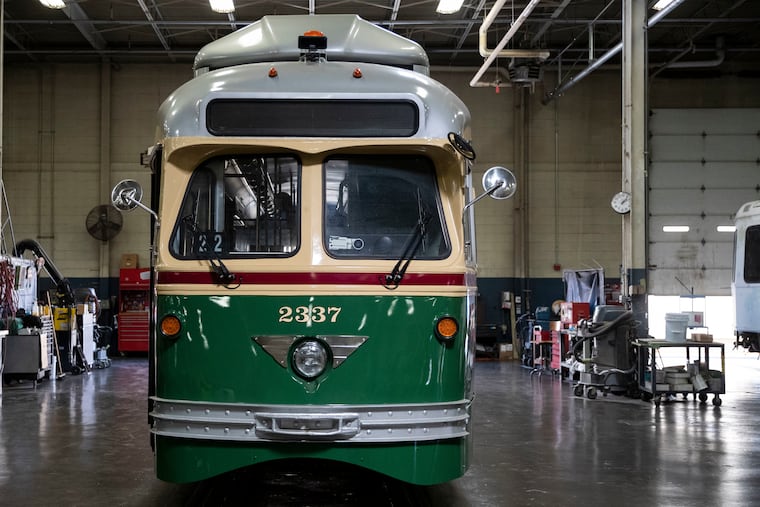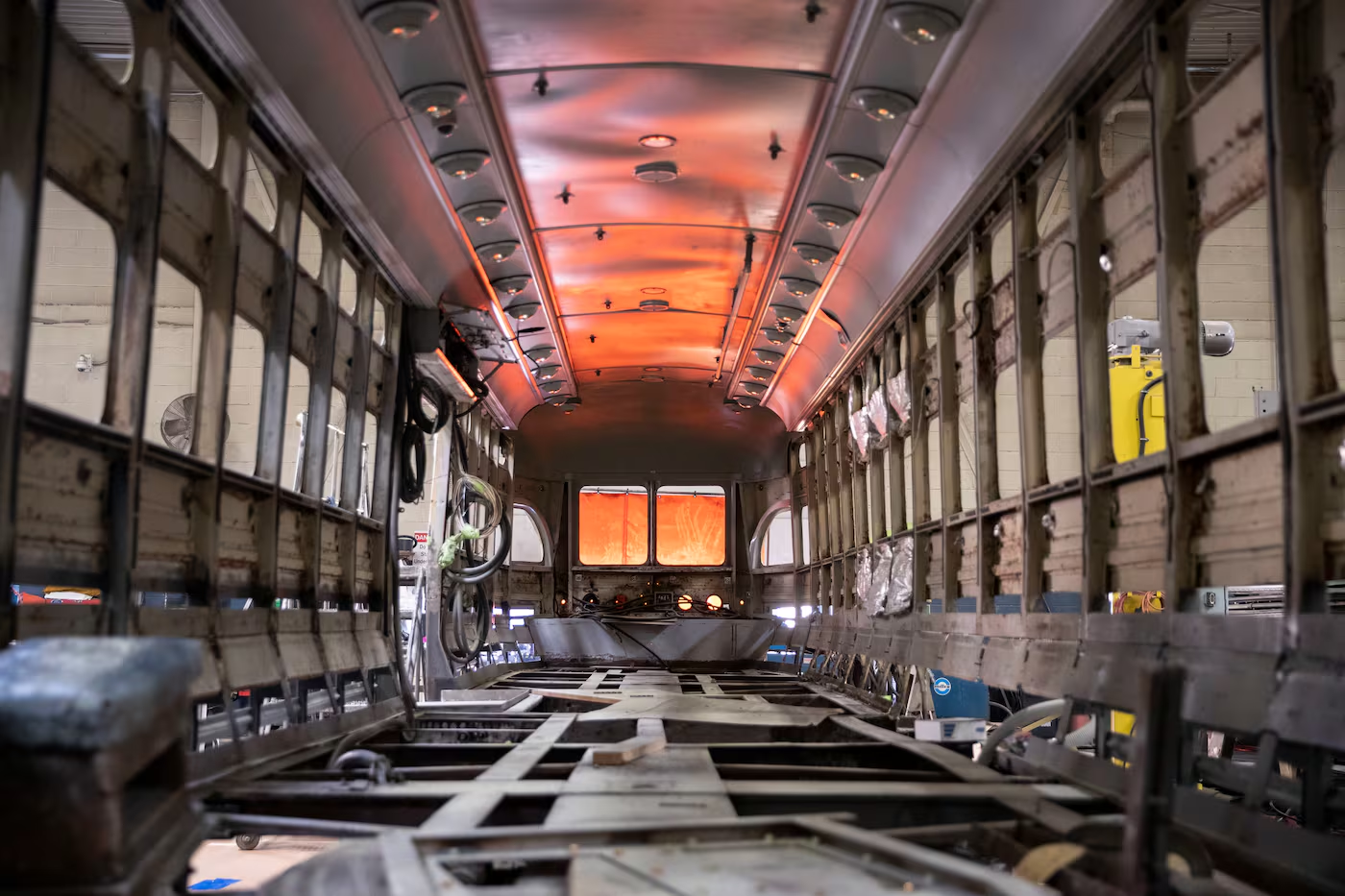FROM RUST BUCKET TO RIDE

Resurrecting transportation history in a SEPTA trolley shop.
Workers tended to four ancient trolley cars in various stages of undress on Monday, their mallets banging on sheet metal inside SEPTA’s Woodland Shops in the Kingsessing section of Philadelphia.
Every workday for 30 months, SEPTA restorers have been taking apart and rebuilding, piece by piece, the city’s famous 1947 PCC II trolleys. When the cars were removed from service on the Route 15/Girard Avenue trolley line in January 2020, they arrived at the shops dented, rusty, and in need of complete rebuilding.
For the teams, that has meant working backward, figuring out how to design and build replacement parts for the 75-year-old streetcars by analyzing what’s left of the originals.
“We get there through trial and error; I feel that’s what a lot of engineering is,” said Sabrina Eisl, 35, a senior project engineer at SEPTA who leads the restoration’s design team.
A few moldering PCC II blueprints found at the bottom of some drawers at SEPTA were basically unreadable, Eisl said, and manufacturers’ plans archived at a university offered limited help. Even the latest software to analyze the properties and performance of materials can get you only so far.
Philadelphians love their trolleys, particularly the 18 dinosaur PCC IIs that were still running on Route 15. Cream-and-green trolley plush toys are popular at SEPTA’s gift shop on Market Street. Fan websites, and countless posts on Pinterest, are devoted to them. Some people have been known to hang photos and paintings of the city’s PCC IIs in their homes.

“To me, it’s like an ice cream truck,” SEPTA CEO Leslie S. Richards said. “You know, you hear that bell going and it brings back good memories. ... People just feel attached to the trolleys.”
She said it’s important for the authority to keep at least some PC IIs running as a touchstone, a link to Philadelphia history.
Edward Carruthers, SEPTA’s assistant chief of rail-equipment maintenance, thinks one reason the old cars are so popular is that they are beautiful. “There’s an aesthetic to these — the shape, kind of like the Airstream. You just don’t see things built like this anymore, with the big sweeping curves and the tiers.”
» If you value this kind of journalism, please subscribe today.
Philly’s 150-year trolley history
Trolleys in one form or another have been operating on Philadelphia streets for more than 150 years and, though the street car network has shrunk, there are still five active lines in the city and Delaware County.
In the 1930s, chief executives of private streetcar companies operating in the U.S. and Canada joined together to develop a standard design for the cars, with interchangeable parts. They called themselves the Presidents Conference Committee, or PCC.
Philadelphia got its first PCC IIs in 1947, built by the St. Louis Car Co., one of two major railcar manufacturers in North America at the time. They arrived in the familiar color scheme: cream up top and green beneath, with a maroon stripe separating the two. The Philadelphia Transportation Co. owned and operated them, along with the Market-Frankford and Broad Street Lines; SEPTA took over the private firm in 1968.
Fast forward to 1992, the beginning of a run of deep budget and service cuts in Philadelphia. More than 100 PCC II cars were taken out of regular service on three trolley lines: Route 23, from Chestnut Hill to Center City, at nearly 14 miles the longest streetcar line in the nation; Erie Avenue’s Route 56; and Route 15, along the Girard Avenue corridor. SEPTA said it wanted to resume service on all three with modern light-rail vehicles in a few years.
That led to more than a decade of public demands for the trolleys’ return and political pressure from city leaders, including former Gov. Ed Rendell, who had been mayor when the service was cut. Routes 23 and 56 remain bus lines to this day. Trolley service came back only to the 8.2 miles of Route 15 in 2005, after 18 PCC IIs were patched up at a rail car factory in Southwest Pennsylvania.
But after 15 years, corrosion from water and road salt had eaten into floorboards. Steel struts and beams were covered in rust. Some of the windows leaked. There were holes in roofs. And many of the cream-and-green machines could not pass internal safety inspections, agency officials said.
Major PennDot construction on Interstates 95 and 76 at either end of Route 15 was going to force SEPTA to temporarily substitute bus service for the trolleys anyway in early 2020. So the authority decided to use the time to fully restore restore them, and to do the work in-house this time, including steel and aluminum fabrication.
Getting down to ‘bare bones’
“We’re aiming for September of next year, to be able to run just over half the [Girard Avenue] route all rail, and use buses on the rest,” said Scott Sauer, SEPTA’s chief operating officer, who began his career more than three decades ago as a trolley operator.
They’ll need about 10 finished PCC IIs to make the plan work, Sauer said.
On the shop floor on Monday, the first car in the row of four was stripped down to its frame. Eisl, the engineer, examined a new bolster, a supporting beam that spans the undercarriage of the trolley and will hold one of the trucks, or wheel sets, in place.
Even with best guesses, it’s sometimes not easy to tell what exactly a car is going to need until the skin is peeled off and it’s down to the bare bones, she said.
“Each of these has their own signature,” said A.J. Niznik, a former boilermaker who now tears down and rebuilds antique trolley cars for SEPTA. “A lot of the issues are the same from car to car, but each one has a couple of things that need special attention.” The trick is to recognize them and adjust.
For example, crews found that, in several cars, moisture had seeped in from cracks along the “drip guards,” which sluice away rainwater, and caused metal struts under the body to rust. Solution: extra welds and sealant.
“It’s always a learning process,” said Eisl, who has a background in civil engineering and has worked for SEPTA for seven years. “You’re never bored.”
When it has had metal parts replaced and welds added, a PCC II car gets a coat of primer and the aluminum skirt is bolted in. Then new flooring — marine plywood sandwiched between sheet metal — is installed. And the old wiring, more than 100 miles per trolley car, is yanked. “Like snakes on the ground,” Eisl said.
On Monday, Carruthers, who has been overseeing the project, stood by the fourth car in the line, Number 2337, which is getting some finishing touches before it will go for testing at the Callowhill Depot, including trial runs without passengers. Three coats of paint were applied in one of the shop’s two-story trolley painting booths over about a week.
It gleams, ready for the museum floor. But it’s destined to be a workhorse, not a show pony. Soon enough, Number 2337 will be grinding it out on Route 15 as a regular revenue-generating transit vehicle.
“It’s going to be almost heartbreaking to put these on the street,” Carruthers said. “It’s like your child leaving home.”




